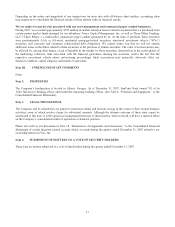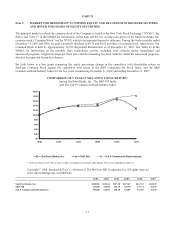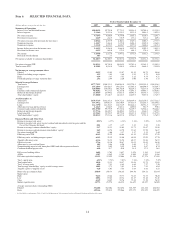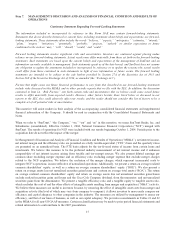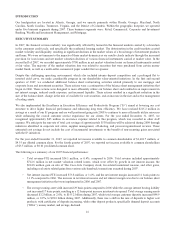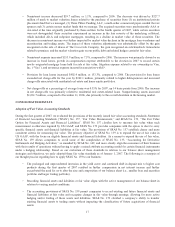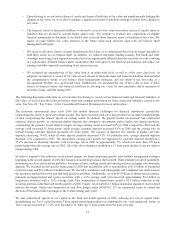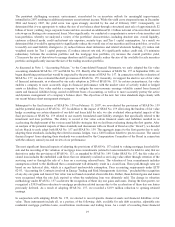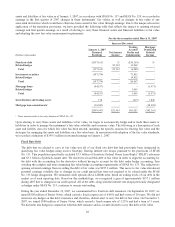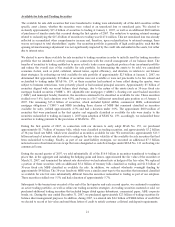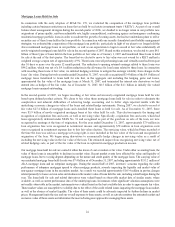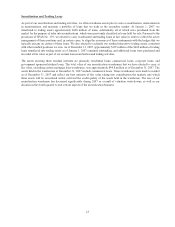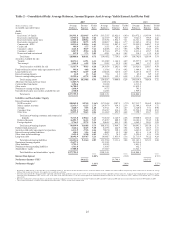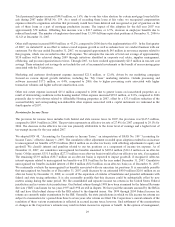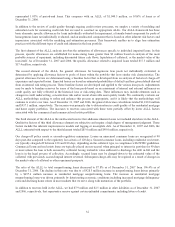SunTrust 2007 Annual Report Download - page 34
Download and view the complete annual report
Please find page 34 of the 2007 SunTrust annual report below. You can navigate through the pages in the report by either clicking on the pages listed below, or by using the keyword search tool below to find specific information within the annual report.
Mortgage Loans Held for Sale
In connection with the early adoption of SFAS No. 159, we evaluated the composition of the mortgage loan portfolio
including certain business restrictions on loans that are held by real estate investment trusts (“REITs”). As part of our overall
balance sheet management strategies during the second quarter of 2006, we decided to no longer retain in our portfolio new
originations of prime quality, mid-term adjustable rate, highly commoditized, conforming agency and nonagency conforming
residential mortgage portfolio loans in order to moderate the growth of earning assets, but had not undertaken plans to sell or
securitize any of these loans held in the loan portfolio. In connection with our recently formulated asset/liability management
strategies, we evaluated the composition of the mortgage loan portfolio, particularly in light of our plans to no longer hold the
above mentioned mortgage loans in our portfolio, as well as our expectation to begin to record at fair value substantially all
newly-originated mortgage loans held for sale in the second quarter of 2007. Based on this evaluation, we elected to carry $4.1
billion of these types of loans held in the loan portfolio at fair value as of January 1, 2007 and transferred these loans to held
for sale at the end of the first quarter. The loans that we elected to move to fair value were not owned by a REIT and had a
weighted average coupon rate of approximately 4.9%. These loans were all performing loans and virtually none had been past
due 30 days or more over the prior 12 month period. The reduction to opening retained earnings related to these loans was
$44.2 million, which was net of a $4.1 million reduction in the allowance for loan losses related to these loans. In connection
with recording these loans at fair value, we initiated hedging activities to mitigate the earnings volatility from changes in the
loans’ fair value. During the twelve months ended December 31, 2007, we sold or securitized $3.4 billion of the $4.1 billion of
mortgage loans transferred to loans held for sale that, in the aggregate and including the hedging gains and losses,
approximated the fair value of the mortgage loans at March 31, 2007, and terminated the interest rate derivatives we had
entered into as hedges of the fair value. As of December 31, 2007, $0.5 billion of the $4.1 billion in initially fair valued
mortgage loans remained outstanding.
In the second quarter of 2007, we began recording at fair value certain newly-originated mortgage loans held for sale
based upon defined product criteria. We chose to fair value these mortgage loans held for sale in order to eliminate the
complexities and inherent difficulties of achieving hedge accounting and to better align reported results with the
underlying economic changes in value of the loans and related hedge instruments. During 2007, we elected to record at
fair value $27.4 billion of mortgage loans and classified these loans as held for sale. As of December 31, 2007, there
were $5.9 billion of newly-originated mortgage loans at fair value held for sale. This election impacts the timing and
recognition of origination fees and costs, as well as servicing value. Specifically, origination fees and costs, which had
been appropriately deferred under SFAS No. 91 and recognized as part of the gain/loss on sale of the loan, are now
recognized in earnings at the time of origination. For the year ended December 31, 2007, approximately $79 million in
loan origination fees were recognized in noninterest income and approximately $78 million in loan origination costs
were recognized in noninterest expense due to this fair value election. The servicing value, which had been recorded at
the time the loan was sold as a mortgage servicing right, is now included in the fair value of the loan and recognized at
origination of the loan. We began using derivatives to economically hedge changes in servicing value as a result of
including the servicing value in the fair value of the loan. The estimated impact from recognizing servicing value, net of
related hedging costs, as part of the fair value of the loan is captured in mortgage production income.
Our mortgage loans held for sale are carried at either the lower of cost or market or fair value. Under either accounting basis, the
value of these loans is susceptible to declines in market value. Recent market events have affected the value and liquidity of
mortgage loans, but to varying degrees depending on the nature and credit quality of the mortgage loans. The carrying value of
our residential mortgage loans held for sale was $7.4 billion as of December 31, 2007, including approximately $153.2 million of
Alt-A mortgage loans and no subprime mortgages. During the second half of 2007, investors’ concerns regarding the credit
performance of subprime mortgages spread to other mortgage products, severely impacting the liquidity and market value of
non-agency mortgage loans in the secondary market. As a result, we recorded approximately $165.4 million in pre-tax charges
related primarily to losses on loan sales and declines in the market value of loans held for sale, including related hedges during the
year. The loans held for sale and related derivatives were valued based on observable market data of similar assets, where
available, as well as current performance data of the underlying loans. In instances when significant valuation assumptions were
not readily observable in the market, instruments were valued based on the best available data in order to approximate fair value.
These market values are susceptible to volatility due to the effect of the credit related issues impacting the mortgage loan market,
as well as the absence of market liquidity. The value of these assets could be adversely impacted by further declines in market
prices. Management limits the size and our overall exposure to these assets, as well as actively monitors the estimated market and
economic value of these assets and determines the most advantageous approach to managing these assets.
22


